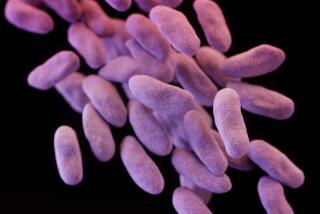Like Party Guests, Germs Love the Kitchen
- Share via
Danger is not, in fact, my middle name--but I’m beginning to think it should be. After all, when I swim in public pools I’ve been known to let some water get in my mouth, which increases my risk for “recreational water illnesses” caused by bacteria clinging to people’s derrieres, according to government health sources (https://www.cdc.gov).
Worse than that, I eat raw vegetables (which can harbor bacteria that make one sick). And I don’t as a rule stick a meat thermometer into each and every burger patty at a cookout to make sure it has reached at least 160 degrees, as recently advised by the U.S. Department of Agriculture (https://www.ars.usda.gov/is/np/fnrb/fnrb401.htm). I do broil my patties to oblivion, British-cooking-style. But while incinerating bacteria, this practice likely increases the level of carcinogens in the meat. (As they say: Out of the frying pan, into the fire.)
I’m not totally reckless. For instance, I don’t wear wide, high-heeled shoes, which increase the risk for arthritis of the knee, according to the latest science out of Harvard Medical School. And I don’t spring-clean my home, which can be hazardous if not performed correctly, according to the American Academy of Orthopaedic Surgeons. Among other things, the academy reminds us that each year more than 511,000 people need medical treatment after improper use of ladders and that it is not smart to stick fingers in lawn mower blades.
But I do other risky things--like hang out in my home, touch doorknobs and prepare meals. Here’s a few findings from the lab of microbiologist Chuck Gerba (a.k.a. “Dr. Germ”) of the University of Arizona. In one study, Gerba’s group sampled people’s hands for illness-causing bacteria and found those who’d just prepared a meal had more microbes on them than those who’d just cleaned a house or petted a dog or cat--more, even, than the grubby paws of a child fresh home from school. The lowest bacterial counts? From the hands of a person who’d just used a public restroom.
Gerba has also calculated that if a phone receiver is touched by the contaminated hands of someone with diarrhea, “the next user could have 107,104 Salmonella cells on the fingertip” and easily transfer 36,383 cells to the mouth. (Tell that to your phone-hogging teen.)
Interestingly, Gerba has found from swabbing 15 homes for germs that the kitchen, not the bathroom, is the most germ-rich part of the home, especially drain areas, counter tops, cutting boards and faucets. The grand prize: the kitchen sponge, with an average count of 780 million bacteria! Less dirty than all of the above: the toilet seat.
I can’t wait to tell my Mom. She was so horrified the day she caught my brother and me, as young kids, eating fish and chips in the bathroom. What, were we supposed to eat it in the kitchen?
Home, Clean Home
The fact that so many of us are going about our business in spite of our filthy kitchen sponges underscores the fact that no one knows how many microbes it takes to make someone sick. And, of course, a bit of disinfecting helps keep down bacteria counts. But some folks have grander, more soaring visions than that! Not far from L.A.--even as you read this--builders are busy working away on what sounds like a Howard Hughes dream home--a glittering, 11,000-square-foot antimicrobial house.
Areas of the house prone to contamination by molds and bacteria will be constructed of steel coated with a substance that discourages growth and survival of microbes, says Alan McCoy, spokesman for a company called AK Steel. We’re talking air-conditioning and heating systems. Doorknobs. Food preparation areas. Refrigerators.
The trick of the coating? When it gets wet, it spits out silver ions, a metal that bacteria and molds don’t like. (The ancient Greeks used to store their water in solid silver containers for just this reason.) Even carpets and wall coverings in the house will be coated with some antimicrobial substance. (Just avoid shaking hands, standing near or kissing anyone and you should be in the clear.)
There are no plans for any antimicrobial tract homes yet, so I guess I’ll have to keep on washing my hands and plying disinfectant. In any case, McCoy reminds us, such a house “does not eliminate the need for good hygiene.”
*
If you have an idea for a Booster Shots topic, write or e-mail Rosie Mestel at the Los Angeles Times, 202 W. 1st. St., Los Angeles, CA 90012, rosie.mestel@latimes.com.
More to Read
Eat your way across L.A.
Get our weekly Tasting Notes newsletter for reviews, news and more.
You may occasionally receive promotional content from the Los Angeles Times.










